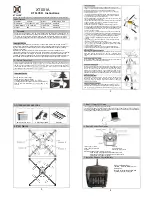
8.Adjustment and setting the Flight
Automatic frequency
Pull the throttle stick to the highest points and
pull back to the lowest point, the automatic
frequency is completed before the aircraft is
started. A orange light indicates the completion
of the frequency adjustment
Mode
Icon
Aileron
Elevator
T
hrottlo
Rudder
Calibration gyroscope
Push the left stick to
the bottom right
corner, while the right
stick is pushed to the
bottom left corner
Red LED lights
flash, red light
stops flashing,
the calibration is
complete
Headless mode
Push the left stick to
the bottom left corner,
push the right stick to
the bottom right
corner. LED red light
flash twice, pause one
time
RED LED lights
flash twice,
pause one time
5
9. 360 ° Eversion and fast and slow speed switch
1. Press the throttle rocker switch on the left,
then the remote give out “DD”, and get the fast speed mode.
2. Slowly raise the throttle stick.
3. Operate the aircraft to maintain stable flight status.
4. When the aircraft is stable, press the
direction of the rocker switch,
then direction stick to any one direction, to flip the aircraft.
Step two
Model
Icon
Flip right
Flip Left
Flip forward
Flip back
Press the button on the top left corner:
"D" indicates slow mode
"DD" means fast mode
(The default mode is slow)
6
10. How to exclude flight status
Status
Cause
Countermeasure
Connect aircraft battery,
the receiver keeps
flashing lights, operating
without reaction
Remote control and
receiver not on the
frequency
Please re-frequency
Connected to the aircraft
battery, no reaction.
1.Check the remote control
and the receiver is powered
2.Check the battery voltage
3.BBattery positive and
negative film is bad
1.Reconnect the battery
2.Full use of rechargeable
batteries
3.Reconfirmed battery positive
and negative, correct exposure
When the push throttle
stick, the motor does not
turn, the receiver
indicator light starts
blinking
Aircraft battery is not
enough
Charge the battery, or replace it
with a full battery
Aircraft vibration fast
1.Propeller deformation
2.Motor problem
1.Replace the propeller
2.Replace the motor
11. Each Part Name
7
Number
Name
Number
Name
1
Protective cover
2
Connector
3
Protection bar
4
Decorative cover
5
PCB
6
Battery
7
Propeller A
8
Propeller B
9
Motor forward rotation
10
Motor reverse
11
Body frame
Precautions
1. Remote control or aircraft electricity shortage, the aircraft will fall down or shorten the flying distance.
2. If the aircraft power is low, it will take off difficult or fly in short distance.
3. If the aircraft appears damaged, deformed, please repair the damage parts. Do not fly otherwise it will
cause injury.
4. If long-term no use the remote controller's battery, please remove it to prevent the battery leakage.
5. The aircraft crash or serious collision will damage or shorten the life of the aircraft.
6. Non-original batteries and chargers cannot be used instead.
12.Parts
Body frame
Protective cover
Decorative cover
Battery
Remote control
Propeller A/B
USB charger
cable
Moto
Receiving
circuit board
Transmitting
circuit board
WARNING: This device complies with Part 15 of the FCC Rules.
Operation is subject to the following two conditions:
(1) This device may not cause harmful interference.
(2) This device must accept any interference received, including interference that may cause
undesired operation.
CAUTION: Changes or modifications not expressly approved by the party responsible for
compliance could void the user’s authority to operate the equipment.
NOTE: This equipment has been tested and found to comply with the limits for a Class B digital
device, pursuant to Part 15 of the FCC Rules. These limits are designed to provide reasonable
protection against harmful interference in a residential installation. This equipment generates,
uses, and can radiate radio frequency energy and, if not installed and used in accordance with
the instructions, may cause harmful interference to radio communications. However, there is no
guarantee that interference will not occur in a particular installation. If this equipment does
cause harmful interference to radio or television reception, which can be determined by turning
the equipment off and on, the user is encouraged to try to correct the interference by one more
of the following measures:
• Reorient or relocate the receiving antenna.
• Increase the distance between the equipment and receiver.
• Connect the equipment into an outlet on a circuit different from that to which the receiver is
connected.
• Consult the dealer or an experienced radio/TV technician for help.
Distributor: XT FLYER LIMITED
8




















